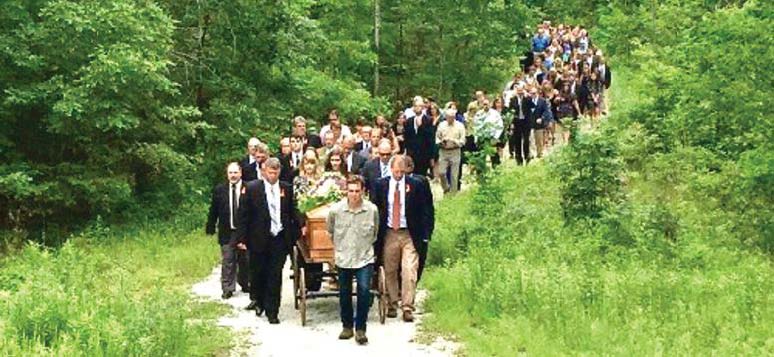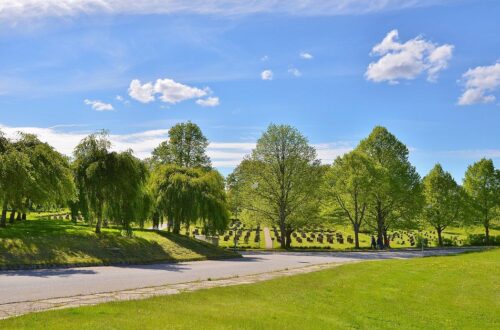Choosing an Eco-Friendly Green Burial
#1 Forego Embalming
Embalming is used to temporarily inhibit the decomposition process and involves the use of formaldehyde, a toxic chemical that has been shown to cause higher rates of certain types of cancer in workers who perform embalming (Beane, Blair, and Lubin 2009). Depending on the circumstances of death, a dead body poses no health risk when kept in a 65° room for up to three days, and decomposition is slowed by natural cooling.
What you can do:
• Ask for the use of a refrigeration unit
• Ask for the use of dry ice or Techni-ice
• Ask that they use a nontoxic embalming agent (many of which can be applied topically)
• Keep or bring the body home, using dry ice or Techni-ice, air conditioning if necessary, or open a window in cool weather
What to look out for:
Claims that an embalming agent is “green” or “eco-friendly” because it is formaldehyde-free when, in fact, its effectiveness is attributed to other toxic chemicals
#2 Forego Concrete Vaults
Concrete vaults house caskets in the ground. Some vaults even look like caskets, only bigger, while others look like cement boxes. Once its lid is in place, a concrete vault helps maintain a level soil surface for ease in lawn mowing by preventing soil settlement, resulting in the manicured appearance observed in conventional lawn cemeteries. The production of concrete and its ingredients requires significant energy, resulting in the generation of carbon dioxide. Vaults also create a barrier between the casket and the earth, prohibiting the natural decomposition process.
What you can do:
• Ask if a shroud may be used
• Ask if a casket containing a lid that will collapse may be used
• Offer (if you wish) an additional contribution to the cemetery’s endowment care fund to compensate the cemetery for possible maintenance required to level off the gravesite, such as adding soil periodically
What to look out for:
Claims that concrete is natural and therefore vaults are “green” — while concrete comes from natural sources, the mining, manufacturing, and transporting of cement and concrete results in environmental harm because of associated carbon emissions
Butterdishing — eliminating the barrier between the casket and the earth by inverting the vault. Inversion of a vault (putting the casket in the ground first and then placing the vault over the casket face down) is not an eco-friendly alternative because the environmental impact due to the manufacturing and transportation of the vault is not eliminated.
#3 Replace Toxic Burial Containers
Too often, caskets are made using toxic chemicals that may be harmful to workers. In addition, some caskets are made with materials that require large amounts of energy, either because of their content such as metal, or because they have been shipped long distances. Other caskets, even though constructed from “natural” materials, may cause environmental harm because such materials have not been harvested in a sustainable manner, such as timber that comes from clear-cut forests.
What you can do:
• Ask if the casket is made from sustainably harvested wood
• Ask if the liner of the casket is made of organic material
• Ask if the product or its components were transported over long distances to reach the consumer (>3000 miles)
• Ask what is known about the finishes and adhesives that are used. Do they contain plastics, acrylics, or similar synthetic polymeric materials?
• Ask if the product has been reviewed by an independent, third-party trust provider such as the GBC
• Consider using a shroud instead of a casket —a shroud can be made from simple cloth obtained from a local fabric store. Growing numbers of shrouds are now being manufactured with handles and stability boards that make them easier to carry and to lower into a grave.
• Consider having a casket or shroud crafted by a local artist or craftsperson, using locally-sourced organic materials
What to look out for:
Keep in mind that terms like “natural,” “sustainable,” and “green” could be meaningless if not readily understood and verifiable by a consumer or certified by an independent, third-party trust provider
Claims of “biodegradability,” while important in helping reduce waste in landfills, mean very little in this context, especially since almost any material will eventually break down in the earth. Statements about “different shades of green” — this phrase is often used to obfuscate and confuse
# 4 Maintain & Protect Natural Habitat
One of the most compelling reasons to choose green burial is the promise that it preserves or restores natural habitat.
What you can do:
• Choose a green cemetery with legal protections that prevents the land from becoming (or returning to) a conventional cemetery and that has established a fund for long-term maintenance
• Ask if the cemetery has a restrictive covenant or a conservation easement on the property
• Ask if the cemetery puts at least 5% of the sales from burial plots into an endowment fund
• Also ask who has oversight of the fund
What to look out for:
Cemeteries that make long-term promises without an endowment fund or that lack the oversight to ensure the security and proper use of the fund
Rules and regulations that promise protection can easily be amended. Be wary of cemeteries that claim permanent protection based solely on their rules and regulations.
Buyer Beware
If you find that providers are unable or unwilling to accommodate your requests, we encourage you to shop around for one that will. If you have questions about the cemetery, funeral home, or products you’re considering, contact the Green Burial Council at 888-966-3330 or email info@greenburialcouncil.org.
Resources
Beane Freeman L, Blair A, Lubin JH, et al. Mortality from lymphohematopoietic malignancies among workers in formaldehyde industries: the National Cancer Institute cohort. J Natl Cancer Inst. 2009; 101:751–7
For more info: www.greenburialcouncil.org
Photo courtesy of Kimberley Campbell, Ramsey Creek Preserve, Westminster SC
THANKS TO THE GREEN BURIAL COUNCIL






